Unless otherwise indicated, the only Mi-8 variants described in this chapter are those once based in the GDR with the Group of Soviet Forces in Germany.
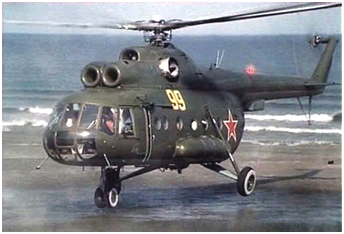
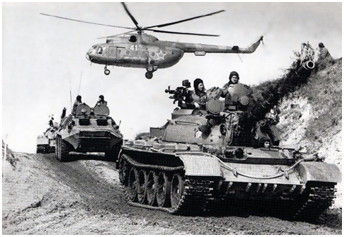 Un Mi-8T survole une colonne blindée est-allemande composée de chars T-55 et de transporteurs de troupes BTR-60 en route vers l'Elbe en 1980. © DR.
Un Mi-8T survole une colonne blindée est-allemande composée de chars T-55 et de transporteurs de troupes BTR-60 en route vers l'Elbe en 1980. © DR.
A Mi-8T flying over an East German armoured column composed of T-55 tanks and BTR-60 APCs, on their way to the Elbe in 1980. © DR.
One does not introduce the Mil Mi-8 and its numerous variants and sub-variants anymore. Trying to describe all of them would be quite a challenge and would reach far beyond
the scope of this site. The first flight of the V-8 dates back to June 24, 1960. It was then an helicopter powered by a single turbine and it included numerous Mi-4 parts.
The V-8A twin-engine version made its first untethered flight on September 17, 1962 and serial production was launched at Factory No.387 in Kazan' (Tatarstan) in 1965.
The first operational models were Mi-8T (troops) transport variants with circular portholes and Mi-8P versions for the conventional transport of passengers equipped with
rectangular portholes like on the Mi-8T prototypes. A second production line was opened at Factory No.99
in Ulan-Ude (Buryatia) in 1970 exclusively to build civilian helicopters (1) .
All military Mi-8 supplied to the Soviet armed forces indeed were built in Kazan'; it was only in the nineties that military variants also were produced in Buryatia.
Still in production nowadays, the Mi-8 and its derivatives are in some way
the helicopter counterpart of the DC-3/C-47 for the civil and military aviation.
Shortly before the start of the withdrawal of the Western Group of Forces from Germany started, the Mi-8 from disparate production batches numbered about 300.
They included a wide range of variants assigned to Armeyskaya Aviatsiya units - and some VVS units - in East Germany.
These units were using the "Hip" for a variety of missions, ranging from transportation to electronic warfare, including antitank warfare.
This chapter will be divided into three parts:
- Models based on the Mi-8T airframe, except for the electronic warfare variants (two pages).
- Models based on the Mi-8MT airframe, except for the electronic warfare variants (one page).
- Electronic warfare variants based on Mi-8T and MT airframes (four pages).
The transport and assault "Hip"
> Mi-8T / Mi-8TV (1968)
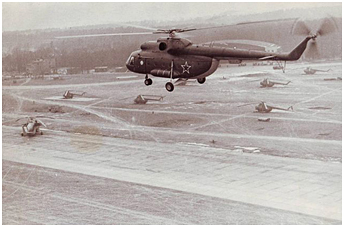
 Un réservoir supplémentaire de 915 litres monté dans la soute d'un Mi-8MT basé à Oranienburg. © H.Mambour.
Un réservoir supplémentaire de 915 litres monté dans la soute d'un Mi-8MT basé à Oranienburg. © H.Mambour.
A 915 liters auxiliary fuel tank inside the cargo hold of a Mi-8MT based at Oranienburg. © H.Mambour.
The first military Mi-8 were simple transport helicopters designated Mi-8T (T for Transportnyy - Transport) "Hip-C."
They were equipped with two Isotov TV2-117A turbines rated at 1500hp (engines built by Klimov from 1965 on) and their tail rotor was on the starboard (right) side.
In addition to a crew of three, these helicopterscould carry 24 soldiers with their weapons, sitting on folding bench seats - less, if one or two additional 915-liter
fuel tanks were mounted inside the cargo hold.
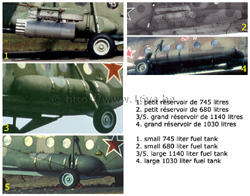 Alternatively, a light vehicle or a gun was likely to be carried. The maximum payload with full fuel tanks was four tons.
This was limited to 2.5 tons under a sling, when a light vehicle or a cannon was hung under a DG-64 hook. The main fuel tanks were mounted on each
side of the fuselage. They were available in two different sizes: 745 or 1140 liters on the left side and 680 or 1030 liters on the right side.
The difference in capacity between the left and right tanks was due to the presence of a KO-50 kerosene heater unit mounted in front of the the right-hand tanks.
That is the reason why there was an air intake on the right side of the fuselage.
In addition, a buffer tank was mounted above the cargo hold, behind the engines. All the kerozene had to transit through that tank to ensure a good fuel supply of the engines.
A capacity of 445 liters is usually mentioned for this tank. However, an old technical manual gives only 346 liters for the Mi-8T and Mi-8P. These data are therefore uncertain.
We did not find pictures showing an Mi-8T or TV equipped with large fuel tanks.
Such is not the case for the Mi-8S and PS, some command and control and electronic warfare models and some Mi-8MT.
Alternatively, a light vehicle or a gun was likely to be carried. The maximum payload with full fuel tanks was four tons.
This was limited to 2.5 tons under a sling, when a light vehicle or a cannon was hung under a DG-64 hook. The main fuel tanks were mounted on each
side of the fuselage. They were available in two different sizes: 745 or 1140 liters on the left side and 680 or 1030 liters on the right side.
The difference in capacity between the left and right tanks was due to the presence of a KO-50 kerosene heater unit mounted in front of the the right-hand tanks.
That is the reason why there was an air intake on the right side of the fuselage.
In addition, a buffer tank was mounted above the cargo hold, behind the engines. All the kerozene had to transit through that tank to ensure a good fuel supply of the engines.
A capacity of 445 liters is usually mentioned for this tank. However, an old technical manual gives only 346 liters for the Mi-8T and Mi-8P. These data are therefore uncertain.
We did not find pictures showing an Mi-8T or TV equipped with large fuel tanks.
Such is not the case for the Mi-8S and PS, some command and control and electronic warfare models and some Mi-8MT.
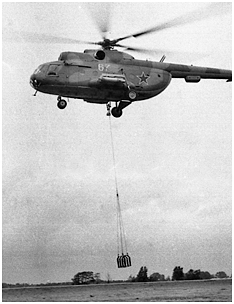 An LPG-2 winch able to lift 150 kg was mounted above the side door to the front left. This winch could also drive a cable running inside the fuselage up to an aperture
in the belly of the helicopter where there also was a DG-64 hook. It was then used to lift the slings up to the hook
(click on the photo at left for a diagram and further explanation). The LPG-150 was another winch model with slightly different characteristics but with an identical carrying capacity.
It could be recognized thanks to a small aerodynamic fairing located on its top. Some helicopters were equipped with FR-100 lights mounted in the fairings of the main landing gear
to facilitate sling transportation at night.
An LPG-2 winch able to lift 150 kg was mounted above the side door to the front left. This winch could also drive a cable running inside the fuselage up to an aperture
in the belly of the helicopter where there also was a DG-64 hook. It was then used to lift the slings up to the hook
(click on the photo at left for a diagram and further explanation). The LPG-150 was another winch model with slightly different characteristics but with an identical carrying capacity.
It could be recognized thanks to a small aerodynamic fairing located on its top. Some helicopters were equipped with FR-100 lights mounted in the fairings of the main landing gear
to facilitate sling transportation at night.
It goes without saying that the first armed version of the Mi-8T was quickly developed and declared operational in 1968. And, already, we step into a
domain where errors die hard, as we will see below.
The transport and assault "Hip" armed with unguided rockets or bombs were from two distinct generations.
The first is the Mi-8TV "Hip-C" and "Hip-E" and the second is the Mi-8MT/MTV-2 alias "Hip-H" that will be discussed in the third page of this chapter
(the latter are often incorrectly identified as the Mi-17, their export designation).
Transport and assault "Hip-C" and "Hip-E" were first-generation helicopters based on the Mi-8T airframe as described in the beginning of this page.
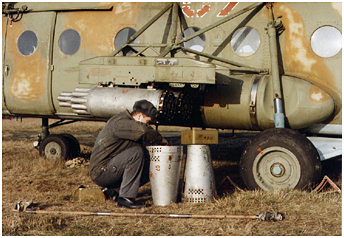
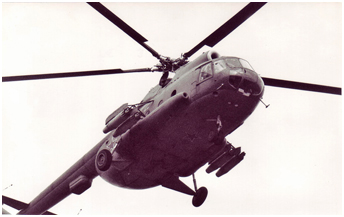 The original Mi-8TV (TV for Transportnyy Vooruzhenyy - Armed Transport / or "TB" in Cyrillic, which will lead to considerable confusion in the West)
from 1968, whose primary function was transporting troops while having a limited offensive capability, was equipped with two removable weapons racks
with two weapon pylons under each one. They could carry four bombs (from 50 to 500kg) or four UB-16-57U rocket pods with 16 KARS-57 (S-5) 57mm rockets loaded in each.
The S-5 rockets could have a classic explosive head, a hollow charge or a hollow charge with splitters.
The maximum payload carried by the weapon racks was 1000kg. Incidentally, an unarmed transport Mi-8T airframe, whether military or civilian, received anchoring points for
the weapon racks (or anything else like external fuel tanks) on the production line.
The original Mi-8TV (TV for Transportnyy Vooruzhenyy - Armed Transport / or "TB" in Cyrillic, which will lead to considerable confusion in the West)
from 1968, whose primary function was transporting troops while having a limited offensive capability, was equipped with two removable weapons racks
with two weapon pylons under each one. They could carry four bombs (from 50 to 500kg) or four UB-16-57U rocket pods with 16 KARS-57 (S-5) 57mm rockets loaded in each.
The S-5 rockets could have a classic explosive head, a hollow charge or a hollow charge with splitters.
The maximum payload carried by the weapon racks was 1000kg. Incidentally, an unarmed transport Mi-8T airframe, whether military or civilian, received anchoring points for
the weapon racks (or anything else like external fuel tanks) on the production line.
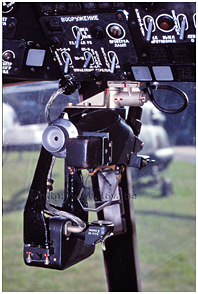
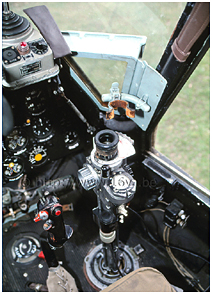 An OPB-1R periscopic optical bombsight was mounted on the right side of the nose, next to the the co-pilot's seat
- it was retractable and the circular aperture of its housing can be seen on photos showing the underside of the fuselage.
Some early production helicopters were not equipped with that bombsight and consequently, there was no circular aperture.
However, the co-pilot was likely to resort to a rudimentary grid placed on the windscreen for low-level bombing.
The pilot had a PKV collimator that he used to fire the S-5 rockets.
In addition, there was a support behind each porthole window that could be opened, so that soldiers could rest a gun on it to fire during flight.
An OPB-1R periscopic optical bombsight was mounted on the right side of the nose, next to the the co-pilot's seat
- it was retractable and the circular aperture of its housing can be seen on photos showing the underside of the fuselage.
Some early production helicopters were not equipped with that bombsight and consequently, there was no circular aperture.
However, the co-pilot was likely to resort to a rudimentary grid placed on the windscreen for low-level bombing.
The pilot had a PKV collimator that he used to fire the S-5 rockets.
In addition, there was a support behind each porthole window that could be opened, so that soldiers could rest a gun on it to fire during flight.
During the Afghan conflict (1979-1989) the Mi-8TVs underwent several improvised upgrades to increase their survivability and their firepower.
The latter also were adapted to the Mi-8MT airframes and applied to the series production of this upgraded version of the "Hip."
However, if these improvements were consequently observed in the GDR on the Mi-8MT, it was not the case for the Mi-8TV based in Eastern Germany.

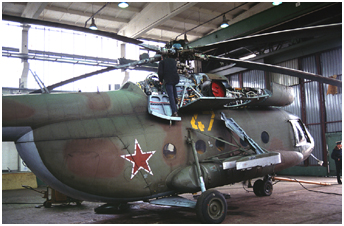 These modifications included the addition of external armor plates 5mm thick on the sides of the nose,
ASO-2V flare launchers under the tail boom, and sometimes
a SOEP-V1A Lipa IR jammer (read > The Mi-24, part 1 for more information about these systems). Some helicopters also received
EVU units (Ezhectorno-Vikhlopnogo Ustroystva - exhaust ejector) to dilute the exhaust gasses.
The armament carried was more varied. A Kalashnikov PKT 7.62 mm machine gun attached to a NUV-1 pivot was mounted in the nose.
Also, one PKT machine gun could be fixed above each weapon rack.
Moreover, it was possible to mount two PKT machine guns inside the helicopter on its sides. A dedicated cross-bar could be attached in the opening of the left side door
to hold a weapon. Also, there was a hatch in the right clamshell door where another PKT machine gun could be mounted.
Similarly, AGS-17 grenade launchers could be mounted inside the cargo hold instead of machine guns.
These modifications included the addition of external armor plates 5mm thick on the sides of the nose,
ASO-2V flare launchers under the tail boom, and sometimes
a SOEP-V1A Lipa IR jammer (read > The Mi-24, part 1 for more information about these systems). Some helicopters also received
EVU units (Ezhectorno-Vikhlopnogo Ustroystva - exhaust ejector) to dilute the exhaust gasses.
The armament carried was more varied. A Kalashnikov PKT 7.62 mm machine gun attached to a NUV-1 pivot was mounted in the nose.
Also, one PKT machine gun could be fixed above each weapon rack.
Moreover, it was possible to mount two PKT machine guns inside the helicopter on its sides. A dedicated cross-bar could be attached in the opening of the left side door
to hold a weapon. Also, there was a hatch in the right clamshell door where another PKT machine gun could be mounted.
Similarly, AGS-17 grenade launchers could be mounted inside the cargo hold instead of machine guns.
> Photos of a Mi-8T with armor plates, nose machine gun, PKT machine guns mounted on outriggers, EVU units and flare launchers:
Photo 1 - Photo 2.
Let's close this Afghan section to return to East Germany and note that the Mi-8 based in the GDR as observed in the early 1990s benefitted
from a high level of standardization.
Thus, the radio equipment was standard and any different antenna observed indicated a helicopter modified for a specific mission such as the Mi-8TARK or the Mi-8T converted into a
VIP configuration as described in the next page.
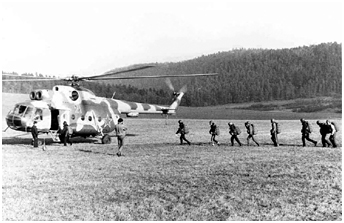
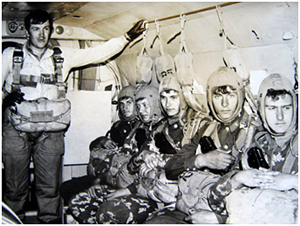 Des Spetsnaz de la 794ème Compagnie à destination spéciale (ORSN) à bord d'un Mi-8T du 336.OBVP de Nohra. © O.Kondrachov.
Des Spetsnaz de la 794ème Compagnie à destination spéciale (ORSN) à bord d'un Mi-8T du 336.OBVP de Nohra. © O.Kondrachov.
Spetsnaz of the 794th Special Purpose Company (ORSN) aboard a Mi-8T from the 336.OBVP based at Nohra. © O.Kondrachov.
"Hip-C" also were used to drop amateur or combat parachutists (2).
Also, the pilots had to maintain a parachutist qualification and other members of the garrisons could take advantage of opportunities offered to them to jump.
The An-2, An-14 and Mi-8 were used as jumping platforms. When parachutists jumped from an armed Mi-8 (Mi-8TV of 1968 vintage) via the left side door, a protective grid could be
mounted in front of the left weapon rack to prevent a parachute from remaining hooked to it.
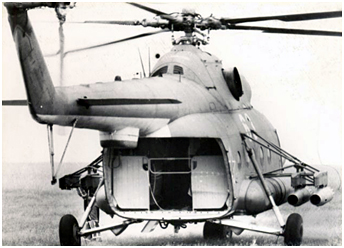
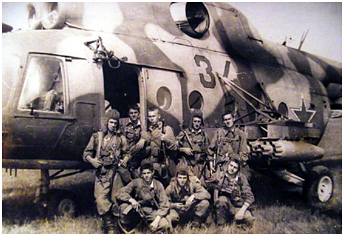 The paras jumped through that door in free fall, which was not the case
when they jumped like the airborne troops with an automatic parachute opening thanks to a strap attached to a cable fixed to the ceiling of the cargo hold.
The paratroopers indeed generally left the helicopter from the rear of the hold, of which the doors had been removed for the occasion.
Two removable walls were mounted on each side of the rear cargo compartment, while a small portico closed the aperture
left between them. In addition to preventing accidental falls, this made it possible to control and channel the paratroopers -
a very similar configuration could be found on other platforms such as the An-26.
Note also that the cargo doors were sometimes removed simply to allow a prompt disembarkation of troops on the ground from the rear.
The paras jumped through that door in free fall, which was not the case
when they jumped like the airborne troops with an automatic parachute opening thanks to a strap attached to a cable fixed to the ceiling of the cargo hold.
The paratroopers indeed generally left the helicopter from the rear of the hold, of which the doors had been removed for the occasion.
Two removable walls were mounted on each side of the rear cargo compartment, while a small portico closed the aperture
left between them. In addition to preventing accidental falls, this made it possible to control and channel the paratroopers -
a very similar configuration could be found on other platforms such as the An-26.
Note also that the cargo doors were sometimes removed simply to allow a prompt disembarkation of troops on the ground from the rear.
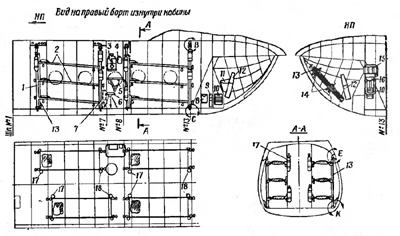 Aménagement à 12 civières de la soute d'un Mi-8T.
Aménagement à 12 civières de la soute d'un Mi-8T.
Layout of an Mi-8T cargo hold with 12 stretchers.
Another temporary modification consisted of converting an helicopter into a medical variant simply by mounting six stretchers on one side of the fuselage,
or by equipping the entire cargo hold with twelve stretchers and a minimum amount of medical equipment.
The Mi-8 for some years also played the rather unusual role of light aircraft interceptors.
It seems that an alert system was established after the Berlin crisis in 1961. Mi-4s and later Mi-8s were ready to take off from their home bases,
other airfields, or from outposts like the air defense radar sites located along the inner German border.
The Mi-24 was better armed and faster, and they logically took over that task from 1976 on
(see > The Mi-24, part 2).
Potential targets of the Mi-8 were essentially of three different types. There were spy balloons that flew normally at very high altitude
(usually, helicopters barely flew above 600 meters to drop skydivers).
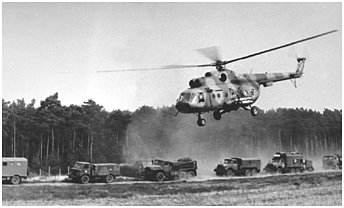
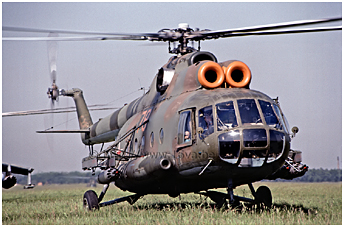 There were also West German private airplanes and gliders that regularly crossed the border, by mistake as one can imagine.
Finally, NATO helicopters patrolling along or too close to the border at less than five kilometers had to be watched.
Valeri Belichenko remembers:
"Until 1976, 239.OGVP crews stood combat alert in the PVO system. I don't know the exact date, perhaps 1961-1962. They also flew the Mi-4.
Alert took place during the summer at the radar posts at Grevesmühlen, Wachstedt, Geba and Hillersleben (the latter did not exist during my time)
and, during the winter, at Parchim and Nohra airfields during daylight hours and at Readiness N°2. I arrived at the regiment in December 1971.
My first alert duty as pilot-navigator was during the summer of 1972 at the Wachstedt radar site. I was there for 17 days. One crew set the record of 27 days.
After that, things were regulated and, in accordance with the NIAS [Aviation Engineering Service Manual], the shift changed every 10 days (weather permitting).
In 1974, combat alert at the Stelzen radar site was added. I was at all of them except Nohra. Crews with a day VFR, day IFR and night VFR rating were assigned
combat alert; after 1974, only first- and second-class pilots were assigned."
There were also West German private airplanes and gliders that regularly crossed the border, by mistake as one can imagine.
Finally, NATO helicopters patrolling along or too close to the border at less than five kilometers had to be watched.
Valeri Belichenko remembers:
"Until 1976, 239.OGVP crews stood combat alert in the PVO system. I don't know the exact date, perhaps 1961-1962. They also flew the Mi-4.
Alert took place during the summer at the radar posts at Grevesmühlen, Wachstedt, Geba and Hillersleben (the latter did not exist during my time)
and, during the winter, at Parchim and Nohra airfields during daylight hours and at Readiness N°2. I arrived at the regiment in December 1971.
My first alert duty as pilot-navigator was during the summer of 1972 at the Wachstedt radar site. I was there for 17 days. One crew set the record of 27 days.
After that, things were regulated and, in accordance with the NIAS [Aviation Engineering Service Manual], the shift changed every 10 days (weather permitting).
In 1974, combat alert at the Stelzen radar site was added. I was at all of them except Nohra. Crews with a day VFR, day IFR and night VFR rating were assigned
combat alert; after 1974, only first- and second-class pilots were assigned."
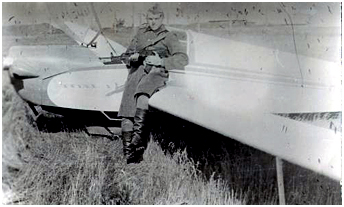 "Besides instruction and monitoring in the regiment, they also sat combat alert
in the zone of the aviation corps command posts (Wittenberg [61.GvIAK] and Wittstock [71.IAK]). We had threatening armament: three pistols and one automatic weapon; the helicopter
itself was not armed. When the intruder did not obey our orders, we forced him to land with the rotor wash.
At the radar site there was an APA [auxiliary power unit] and a TZ [fuel truck] with driver and a cook for the crew.
There was an OBU [combat control officer] from the fighter aviation regiment on duty who controlled us and the alert aircraft in his zone, and an enlisted communicator
with a radio. There were radio, telephone and loudspeaker communications with the radar site command post: one long tone - Readiness N°1; two short tones - start engines;
three short tones - launch. We were called upon to escort Iroquois, Kiowa and Huey Cobra choppers along the border, but they usually didn't cross the line.
Light private and sports planes were the violators. In the summer of 1971, a drunken Dane with two passengers aboard was forced down at Damgarten. The crew (if memory serves)
was flight commander Captain Petrov, pilot-navigator Senior Lieutenant Kurylev and crew chief Senior Lieutenant Tel'noy; they chased him for a long time over the Baltic until finally
forcing him down. In the fall of 1974 the crew of Captain N. P. Zhulidov, pilot navigator Lieutenant A. G. Korenev and crew chief N. S. Polushin forced a lost sports plane down
at the Geba radar site. In a bank during landing, the helicopter damaged a rotor. In all, 239.OGVP crews forced down nine aircraft violators. During the summer of 1976, Mi-24 from the OBVP
took up combat alert."
"Besides instruction and monitoring in the regiment, they also sat combat alert
in the zone of the aviation corps command posts (Wittenberg [61.GvIAK] and Wittstock [71.IAK]). We had threatening armament: three pistols and one automatic weapon; the helicopter
itself was not armed. When the intruder did not obey our orders, we forced him to land with the rotor wash.
At the radar site there was an APA [auxiliary power unit] and a TZ [fuel truck] with driver and a cook for the crew.
There was an OBU [combat control officer] from the fighter aviation regiment on duty who controlled us and the alert aircraft in his zone, and an enlisted communicator
with a radio. There were radio, telephone and loudspeaker communications with the radar site command post: one long tone - Readiness N°1; two short tones - start engines;
three short tones - launch. We were called upon to escort Iroquois, Kiowa and Huey Cobra choppers along the border, but they usually didn't cross the line.
Light private and sports planes were the violators. In the summer of 1971, a drunken Dane with two passengers aboard was forced down at Damgarten. The crew (if memory serves)
was flight commander Captain Petrov, pilot-navigator Senior Lieutenant Kurylev and crew chief Senior Lieutenant Tel'noy; they chased him for a long time over the Baltic until finally
forcing him down. In the fall of 1974 the crew of Captain N. P. Zhulidov, pilot navigator Lieutenant A. G. Korenev and crew chief N. S. Polushin forced a lost sports plane down
at the Geba radar site. In a bank during landing, the helicopter damaged a rotor. In all, 239.OGVP crews forced down nine aircraft violators. During the summer of 1976, Mi-24 from the OBVP
took up combat alert."
On the other hand, the Mi-8s sometimes chased away the opportunity targets: the Western allied military liaison mission vehicles! Bill Burhans of the USMLM remembers: "I know that at least on one occasion an Air Team tour was chased away from Wachstedt (if memory serves!) by an Mi-8 that was quite persistent. The guys had to find some thick woods and hide themselves away from the bird. I always wondered why helicopters weren't used more often in that role to help in the surveillance effort against the Western military missions." More testimonials from the other missions exist, such as the one published by Steve Gibson (BRIXMIS) in his book "The Last Mission," describing his pursuit by an aggressive Mi-8.
The 1968 vintage Mi-8TV were familiary called Mi-8T in service, like the unarmed airframes. Unless otherwise stated in the text and picture captions and to avoid confusion with the next model which reused the same "TV" designation - see next page - this armed version will be designated Mi-8T on this site.
notes
(1)
Helicopters produced after the fall of the Soviet Union bear a different designation, depending on where they are built.
Thus, the basic Mi-8T and Mi-8MT airframes retain those designations when they come out of Kazan, whereas the Mi-8 built at Ulan-Ude
are respectively called Mi-8AT and Mi-8AMT.
(2)
Upon withdrawal from Germany, there were five separate airborne assault battalions stationed in Fürstenberg, Eberswalde, Magdeburg, Dresden and Nohra. One was attached to each
of the five ground armies deployed in the GDR. There was also an independent brigade in Cottbus and an independent Spetsnaz brigade in Neu-Thymen. In addition, Spetsnaz companies were
subordinated directly to the headquarters of the five armies (From S. Büttner, "Beginning of the End" in Aircraft November 2009).
 |
The Mi-8 > Part 2 | > Part 3 | > Part 4 | > Part 5 | > Part 6 | > Part 7 |
 |
Plan du site - Sitemap |  |

